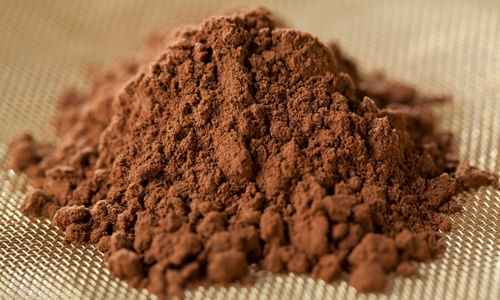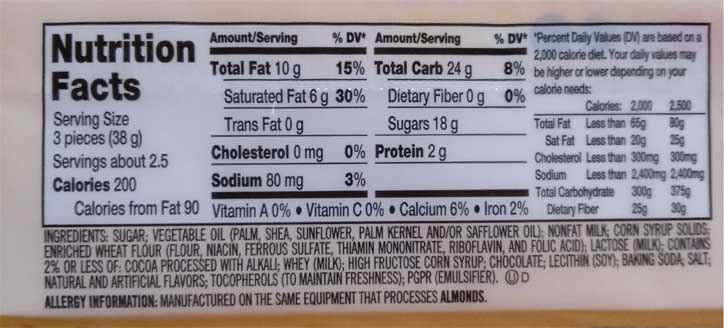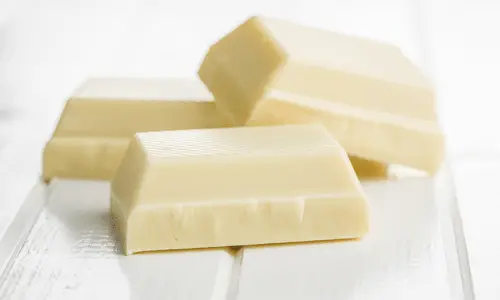White chocolate is a confection made from a combination of milk (powder), sugar, and cocoa butter. Additionally, emulsifiers may be used to improve the texture of the bar.
The quality, taste, and texture of white chocolate vary depending on the cocoa butter, milk, and sweetener percentages and origins.
It gets its name from the fact that the cocoa butter used in its production is processed separately from other cocoa solids, which results in a final product that is white with a slight yellow tint in color.
While white chocolate does contain some cocoa butter, it is significantly lower in cocoa solids compared to milk or dark chocolate, and as a result, does not have the same rich flavor or nutritional value. This is also the reason why white chocolates are seemingly much sweeter than other chocolates.
If you want to know what is in white chocolate, what the difference is, and if white chocolate is considered chocolate, then read on!
What’s In White Chocolate?
According to the U.S. FDA (Food and Drug Administration), white chocolate is defined as:
… a minimum of 20 percent cocoa butter, a minimum of 14 percent of total milk solids, a minimum of 3.5 percent milkfat, and a maximum of 55 percent nutritive carbohydrate sweeteners.
Sec. 163.124 White chocolate.
To break that down, white chocolate should contain (by weight):
- At least 20% cocoa butter
- At least 14% milk solids
- At least 3.5% milkfats
- Up to 55% sugar (or alternative sweetener)
Additionally, emulsifiers are typically used to improve the texture of white chocolate bars. This means a more consistent chocolate product. The amount of emulsifier by weight must be under 1.5% of the total product’s weight.
Does White Chocolate Have Cocoa Solids?

No, white chocolate does not contain cocoa particles (like cocoa powder). This reason is why white chocolate is white. Cocoa solids give chocolate their darker, brown colors.
Cocoa butter is usually the only cocoa ingredient used in white chocolate. The rest of the ingredients are made of sugar, milk (or milk solids), flavoring, and other ingredients to improve the texture/consistency of the chocolate bar.
Differences Between White Chocolate and Chocolate
While white chocolate may use the same cocoa butter from beans used for actual chocolate, there are some differences between white chocolate and traditional chocolate.
For starters, white chocolate is typically sweeter. Cocoa butter is an increasingly expensive ingredient. Sugar is a cheap alternative for making white chocolate. Additionally, cocoa solids contribute a bitter cacao flavor. The lack of cocoa bits in white chocolate makes it seem that much sweeter!
Remember that white chocolate can contain up to 55% sugar (by weight). This means up 55g of sugar in a 100g bar of white chocolate.
As mentioned earlier, white chocolate has no cocoa solids in it. However, the cocoa butter content is what makes white chocolate similar to other chocolates. Otherwise, it would just be a chocolate-tasting candy bar.
Finally, some white chocolates contain vegetable fats (like palm bean or soy oil) to replace the cocoa butter. Chocolate that is made with vegetable oils is called compound chocolate. At this point, it is not chocolate anymore, but a concoction of vegetable fats, milk powder, sugar, and sometimes vanilla.
At the bare minimum, white chocolate should contain cocoa butter as the primary base (to be considered chocolate).
Does White Chocolate Have Caffeine?
Did you know chocolate has a good amount of caffeine in it? Perhaps that is part of the reason why chocolate is so addicting.
This is especially true for dark chocolate as a 100g bar can contain up to 50mg of caffeine.
However, that caffeine comes from cocoa solids, which are not present in white chocolate. This means white chocolate does not contain caffeine.
So Is White Chocolate Actually Chocolate?
It really depends on who you ask and what definitions are accepted. Legally speaking, as long as cocoa butter and milk ingredients are used, it can be considered chocolate.
Some may argue that because of the lack of cocoa solids, white chocolate is not chocolate. But using cocoa butter carries so much texture, aroma, and flavor that makes white chocolate and other chocolates so similar.
High-quality white chocolates feature a higher percentage of cocoa butter while avoiding vegetable fats as a replacement.
Common “White Chocolate” Candy Bars
If you want a sure answer, candy bars like Hershey’s “white chocolate” bars would not be considered chocolate in my book. Cocoa fats are pretty much completely replaced by vegetable oils such as palm, sunflower, or shea oil.

Taking a look at the ingredients label, it is important to note that the ingredients are listed in order of percentage of total weight.


![How to Coat Gummy Candy in Sugar [Without Melting]](https://candyturf.com/wp-content/uploads/2022/10/how-to-coat-gummy-candy.jpg)
